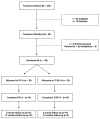Prolonged exposure versus dynamic therapy for adolescent PTSD: a pilot randomized controlled trial
- PMID: 20855048
- PMCID: PMC2945239
- DOI: 10.1016/j.jaac.2010.07.014
Prolonged exposure versus dynamic therapy for adolescent PTSD: a pilot randomized controlled trial
Erratum in
-
Corrigendum.J Am Acad Child Adolesc Psychiatry. 2016 Oct;55(10):920. doi: 10.1016/j.jaac.2016.06.018. J Am Acad Child Adolesc Psychiatry. 2016. PMID: 27663948 No abstract available.
Abstract
Objective: To examine the efficacy and maintenance of developmentally adapted prolonged exposure therapy for adolescents (PE-A) compared with active control time-limited dynamic therapy (TLDP-A) for decreasing posttraumatic and depressive symptoms in adolescent victims of single-event traumas.
Method: Thirty-eight adolescents (12 to 18 years old) were randomly assigned to receive PE-A or TLDP-A.
Results: Both treatments resulted in decreased posttraumatic stress disorder and depression and increased functioning. PE-A exhibited a greater decrease of posttraumatic stress disorder and depression symptom severity and a greater increase in global functioning than did TDLP-A. After treatment, 68.4% of adolescents beginning treatment with PE-A and 36.8% of those beginning treatment with TLDP-A no longer met diagnostic criteria for posttraumatic stress disorder. Treatment gains were maintained at 6- and 17-month follow-ups.
Conclusions: Brief individual therapy is effective in decreasing posttraumatic distress and behavioral trauma-focused components enhance efficacy. CLINICAL TRIAL REGISTRY INFORMATION: Prolonged Exposure Therapy Versus Active Psychotherapy in Treating Post-Traumatic Stress Disorder in Adolescents, URL: http://clinicaltrials.gov, unique identifier: NCT00183690.
Copyright © 2010 American Academy of Child and Adolescent Psychiatry. Published by Elsevier Inc. All rights reserved.
Figures
Comment in
-
Prolonged exposure, time-limited dynamic psychotherapy, and the dodo.J Am Acad Child Adolesc Psychiatry. 2011 May;50(5):519-20; author reply 520-1. doi: 10.1016/j.jaac.2011.03.006. J Am Acad Child Adolesc Psychiatry. 2011. PMID: 21515201 No abstract available.
-
Prolonged exposure and psychodynamic treatment for posttraumatic stress disorder.J Am Acad Child Adolesc Psychiatry. 2011 May;50(5):521-2; author reply 522-1. doi: 10.1016/j.jaac.2011.03.005. J Am Acad Child Adolesc Psychiatry. 2011. PMID: 21515203 No abstract available.
References
-
- Warshaw MG, Fierman E, Pratt L, et al. Quality of life and dissociation in anxiety disorder patients with histories of trauma or PTSD. Am J Psychiatry. 1993;150:1512–1516. - PubMed
-
- Kilpatrick DG, Ruggiero KJ, Acierno R, Saunders BE, Resnick HS, Best CL. Violence and risk of PTSD, major depression, substance abuse/dependence, and comorbidity: Results from the National Survey of Adolescents. J Consult Clin Psychol. 2003;71:692–700. - PubMed
-
- Smith P, Yule W, Perrin S, Tranah T, Dalgeish T, Clark DM. Cognitive behavior therapy for PTSD in children and adolescents: a preliminary randomized controlled trial. J Am Acad Child Adolesc Psychiatry. 2007;46:1051–61. - PubMed
-
- Adler Nevo G, Manassis K. Psychosocial treatment of pediatric posttraumatic stress disorder: The neglected field of single-incident trauma. Depress Anxiety. 2005;22:177–189. - PubMed
Publication types
MeSH terms
Associated data
Grants and funding
LinkOut - more resources
Full Text Sources
Medical
Miscellaneous


